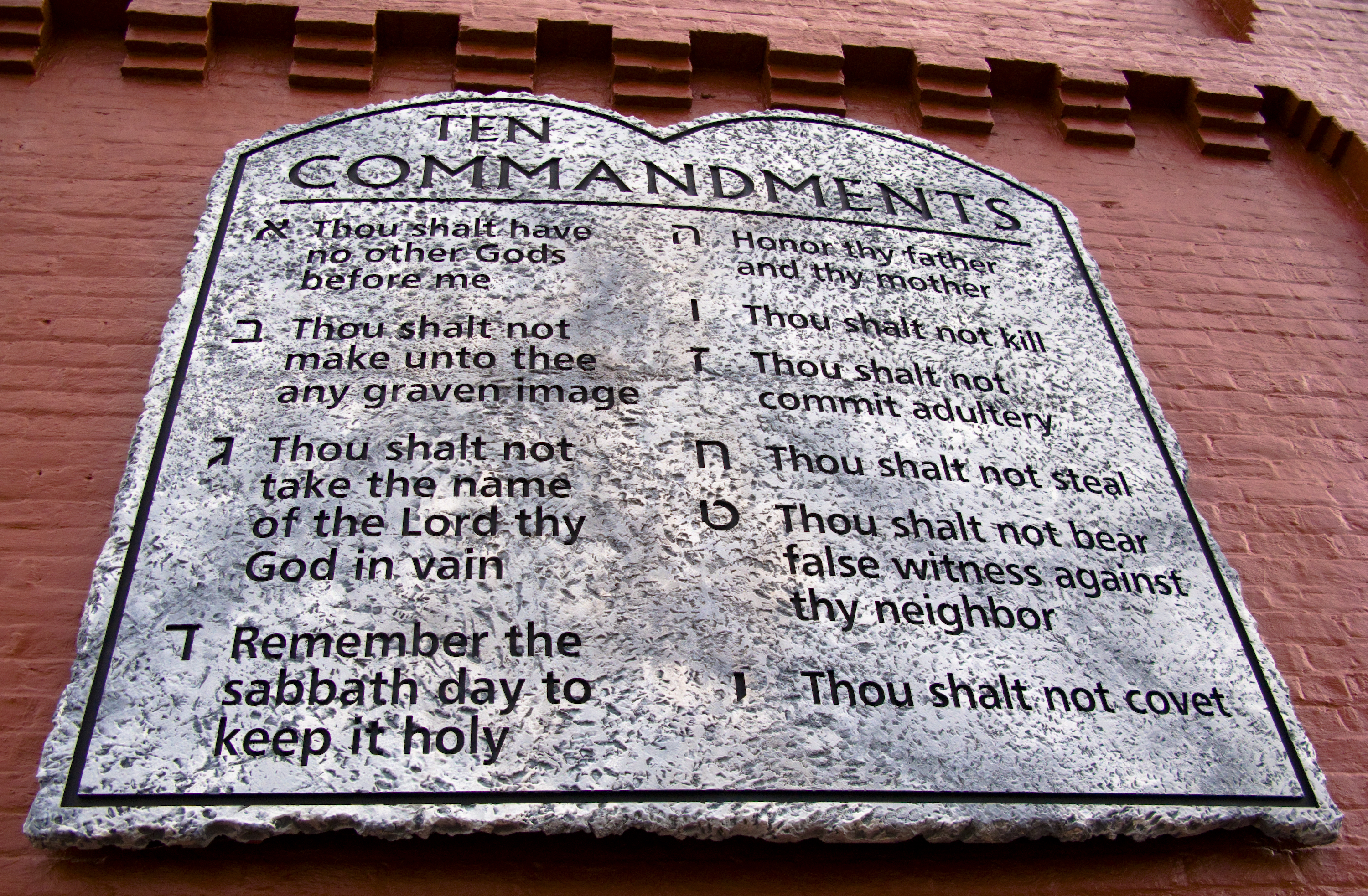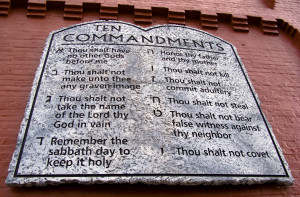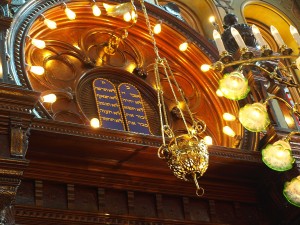Boxers vs. Briefs: Which Does The Toirah Prefer
We begin with a comment from a reader who wrote azoy:
Dear Reb Oisvorfer!
Have been reading your parsha review for nearly 3 years, loving it every week, looking forward each time, sincerely!
We got a little machloikes going at our shul in Cherry Hill, and not sure if you will cover this in the upcoming parsha, so I will ask: in the beginning of the parsha, each time Yisro’s name is mentioned, he is referred to as Moshe’s father in law, again and again. You say year after year that Torah doesn’t waste a single letter, so why tell us that Yisro is Moshe’s father in law so many times? Isn’t it understood? And moreover, when Yisro comes to Moshe, he says “here I am, I am Yisro your father in law and this here with me are your wife and your sons”.
Did he think Moshe would not recognize him and them? Why repeat again and again.
Respectfully,
Jeff Talkoff
Reb Jeff:
It’s mamish heartwarming and givaldig to know that you have been a reader for last three years, ober, where the hec have you been since 2010 when the Oisvorfer began sharing his gems with the masses? The good news is azoy: You can find them in the archives at www.oisvorfer.com. In any event, you do ask a few givaldige kashas. Grada these same questions and many more have been bothering the Oisvorfer for many years. And this week, we will add to yours and then see if we can find some satisfaction. Not the satisfaction you typically seek, chazir that you are. Your questions, Jeff, are all about the very front of the parsha, ober this year, in our sixth edition of parshas Yisroy, the Oisvorfer decided to learn the parsha backwards, from the very last posik (verse) mamish. Grada a few years back the eishes chayil (wife) suggested that reading backwards is an excellent way to proof read a document. Shoin, though the Oisvorfer has not in the past always listened to her advice, nu, efsher he should. This year, we will begin our review of the parsha with the very last posik.
Says the heylige Toirah (Shemois 20:23) azoy: “You shall not ascend My altar on steps, so that your nakedness will not be uncovered upon it.” What the hec is going on here? Would anyone have the chutzpah of ascending the RBSO’s altar commando style, or, without any clothing? What’s pshat here? Says Rashi: The Yiddin were instructed not to build a staircase going up to the altar; instead they were to build a ramp. And why would the RBSO insist on a ramp vs. a staircase? And what do steps have to do with nakedness? Shoin: Rashi of course chapped what the RBSO was thinking and does further expound azoy. Walking up a staircase causes one to widen his steps and during such widening, it is seemingly shayich (possible) that a person standing underneath the staircase, could possibly chap a peek at the erva (privates) of the koihen. In this case, the stones of which the staircase was to be fashioned, might be exposed to a person’s privates. And what’s the big deal if the stones, inanimate object, were to see someone’s nakedness? We’ll get to that in a minute. Ober were the koihanim walking around without underwear? Were they mamish vulnerably exposed? Nu, lets’ go further. Says Rashi: It’s taka emes that the koihanim were instructed to don ‘michnisay bad’ (linen breeches) and these were taka intended ‘to cover the flesh of nakedness’, ober it appears that the breeches were efsher more like boxer shorts, and did not provide for total privacy or security. And says Rabbi Art Scroll, a more contemporary achroin, azoy: …”the Torah frowns upon even the slightest suggestion of immodesty.” Seemingly, were they to have to climb steps, they would also need to widen their paces and thereby efsher allowing for some erva to show. Is the heylige Toirah giving a nod to briefs over boxers? Veyst zich ois (apparently), it’s efsher possible that boxer briefs or even regular briefs are mamish preferred over boxer shorts for they zicher provide more privacy. And says Rashi: although the breeches provided some protection, seemingly it wasn’t enough for the RBSO who insisted on more. Shoin: a ramp it was. And as to why stones could or shouldn’t be exposed to one’s nakedness, we need to look at the penultimate posik (Bereishis 20:22) which says azoy: “And when you make for Me an Altar of stones, do not build them hewn, for you will have raised your sword over it and desecrated it.” Says the Mechilta azoy: The stones of the altar were to be treated as if they were sentient beings. Sacrifices brought upon it served to lengthen mans days (by lifting his sins). Iron was created to shorten the life of man. Something which shortens life should not be placed on something that lengthens life. What has that to do with Koihanim wearing proper underwear, ver veyst?
So much for the back of the parsha; let’s go back to the very beginning.
An early Rashi will tell us that Yisroy had seven names. Why would a person need seven names, ver veyst? Nu, another medrish will teach us Yisroy was an advisor to Paroy who had abandoned his position and ran back to Midyan after hearing Paroy’s plans to put to death all Jewish baby males. Yet another medrish will tell us that Yisroy, after earnestly checking out every form of idol worship known to man, rejected them all and sought to convert to Judaism.
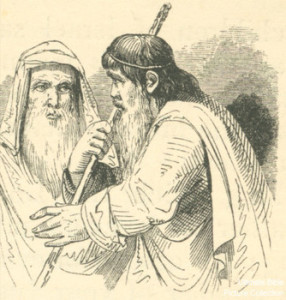 And another: when he rejected idol worship, he was fired as the chief priest of Midyan. As a result he efsher lost his business partners and servants. Therefore, he needed to employ his own daughters as shepherds and of course as a result, Tzipoira happened to be at the well when Moishe, himself on the run, arrived to Midyan. And if Yisroy taka lost his position and maybe his business, of course he lost his livelihood and efsher he also needed to declare bankruptcy, and file for chapter 11. And…maybe he then needed to depend on Medicaid, food stamps and other social welfare programs for support, ver veyst? Ober Yisroy was smart: He chapped that the Yiddin, those that sit and learn in various koilles (Yeshiva for life), were experts in filing for these programs. Shoin: he decided that it’s efsher good to be Jewish. Go prove otherwise! And to support his seven daughters, he filed applications under seven different names. Why not? Go prove otherwise. Shoin, whether he had seven names or not, of course we don’t know with certainty, ober we do know the heylige Toirah does for the most part call him Yisroy the high priest or Yisroy, Moishe’s father-in-law, though there is a mention of the name Riuale. We find that name when the girls went home to tell their father ‘Riuale’ what took place at the well, and how Moishe came to their relief. Could it be that Riuale was their real father and he Yisroy, was but their stepfather or frakert? Maybe: go prove otherwise.
And another: when he rejected idol worship, he was fired as the chief priest of Midyan. As a result he efsher lost his business partners and servants. Therefore, he needed to employ his own daughters as shepherds and of course as a result, Tzipoira happened to be at the well when Moishe, himself on the run, arrived to Midyan. And if Yisroy taka lost his position and maybe his business, of course he lost his livelihood and efsher he also needed to declare bankruptcy, and file for chapter 11. And…maybe he then needed to depend on Medicaid, food stamps and other social welfare programs for support, ver veyst? Ober Yisroy was smart: He chapped that the Yiddin, those that sit and learn in various koilles (Yeshiva for life), were experts in filing for these programs. Shoin: he decided that it’s efsher good to be Jewish. Go prove otherwise! And to support his seven daughters, he filed applications under seven different names. Why not? Go prove otherwise. Shoin, whether he had seven names or not, of course we don’t know with certainty, ober we do know the heylige Toirah does for the most part call him Yisroy the high priest or Yisroy, Moishe’s father-in-law, though there is a mention of the name Riuale. We find that name when the girls went home to tell their father ‘Riuale’ what took place at the well, and how Moishe came to their relief. Could it be that Riuale was their real father and he Yisroy, was but their stepfather or frakert? Maybe: go prove otherwise.
It also so happens that another medrish will tell us that Moishe too had seven names and a few rebbes will argue as to what those names were. Shoin, after skedaddeling out of Mitzrayim where Paroy wanted to kill him and being on the lamb for so many years, one can easily chap why he would need so many names. And if it’s taka emes that he went on to become the king of a country named Kush for a few decades, mistama he didn’t go by the name Moishe; too Jewish. Why the medrish wants us to believe that both Moishe and Yisroy had seven names, ver veyst. Avada it’s all possible, why not?
So happens that every year when parshas Yisroy comes around, the parsha which contains the deliverance of the Aseres Hadibrois (Ten Commandments), the most seminal of all events in our glorious history, we ask this question: Why are the Aseres Hadiboris found in a parsha named after a goy, an idol worshipper who was mamish a priest? Shouldn’t a parsha which features a visit by the RBSO Himself have epes a better name? On the other hand, if the story of Yisroy is somehow relevant to the Aseres Hadibrois and needed to be included in this parsha, why not name the parsha after Moishe who was the RBSO’s chief emissary? Vus epes Yisroy? And taka this question has vexed so many for over 3300 years. Moreover, wouldn’t we expect to find lots of, and efsher most of the discussion from the myriad commentators, to be about the Aseres Hadibrois? Instead, while there is avada some medrish on the Aseres Hadibrois, ruba diruba (the great majority) of the exegesis concerns the first two words of the parsha. These two words are ‘Vayishma Yisroy’ (Yisroy heard). Pages and pages of medrish can be found in trying to chap pshat in these words. Seemingly Yisroy heard something. The heylige Toirah does not tell us what, ober, nearly every other rabbi does. Most seem to agree that what Yisroy heard was that the RBSO redeemed His people from Mitzrayim, split the sea, and also about the victory (of sorts) that the Yiddin enjoyed following the sudden sneak attack by Amolake. Who the hec was Amolake? Why did he wage war? Were the Yiddin bothering him? Shoin, let’s then start here.
So happens that we first met Amolake way back and in the very back of parshas Vayishlach (Bereishis 36:12) where the heylige Toirah delineated Eisav’s progeny. Who was Amolake? The son of Timna. And who was she? She was the pilegesh (concubine) of Eliphaz who was the son of Eisav. Says the heylige Gemora (Sanhedrin 99 ) azoy: Timna, from an otherwise prominent mishpocho, wanted to join the Yiddin, she wanted to become a proselyte. She went to Avrohom, Yitzchok and Yaakov but was seemingly rejected by all of them. Ober so determined was she to be of the ‘seed of Avrohom’ -so says Rashi- that she became a concubine to Eliphaz who was the son of Eisav. And her reasoning: “I would rather be a servant to this people than a mistress of another nation. And nebech this very well intentioned and sincere woman, gave birth to Amolake. Amolake heard this as he grew up -if this was the original Amolake or a successor to Amolake by the same name is of course hotly debated- and was of course angry at how his mother was treated. Or, pshat is that Amolake, a grandson to Eisav, was still seething over how his zeyda Eisav was snookered by Yaakov. In any event, though the Yiddin were not a threat to Amolake, he chose to wage war. He afflicted the Yiddin when they were still vulnerable. He enraged the RBSO so severely that we are instructed never to forget what Amolake did to us. What he did is recited at the very end of last week’s parsha and is recalled yearly on shabbis zachor where we stand as the chazan reads the few verses which recount how Amolake came and attacked the Yiddin just after the Yiddin miraculously crossed over the Sea of Reeds. As an aside, why we stand for that and other readings including the Aseres Hadibrois, will be discussed below. Seemingly, Amolake’s great sin was that he cooled off the fervor the Yiddin felt after they were witnesses to open miracles. Here they were, all believers who had just broken out into spontaneous song and along came Amolake who attacked them from behind. He had the audacity to challenge the RBSO. And what has all this to do with what Yisroy heard?
Ober listen up to this mamish gishmake and illuminating pshat from someone called the Baal Yalkut HaGershuni who says azoy: Yisroy heard what Amolake did and decided that Amolake attacked the Yiddin precisely because his mother Timna was rejected by our forefathers. Had they accepted her, he too would now be part of the nation that had just seen the RBSO’s might. He was punishing them for turning her away. And being that Amolake succeeded in at least temporarily or efsher even longer term weakening their resolve, Yisroy figured that the Yiddin will not repeat that error, they will not reject his application to become a convert. He thought that this was an especially auspicious time to make his approach. Therefore, we can look at the question that Reb Jeff asked above and try to chap why Yisroy is at the beginning of the parsha referred to as ‘high priest of Midyan’ and Moishe’s father-in-law. This is Oisvorfer’s pshat: First he was coming with some credentials. Hey, here are my bona fides, let me in. I was a high priest and I deserve to be heard. Or, hey, I am Moishe’s father-in-law, let me join you guys. And he repeats it over and again until he is accepted. Could that be pshat? Why not? Go prove otherwise. All the players are long dead.
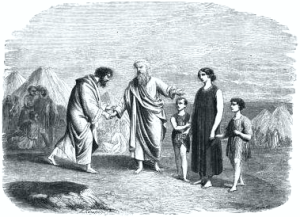 Ober, let’s see what the Sifsay Chachomim have to say: When the heylige Toirah introduces Yisroy at the outset of the parsha, he is described as Moishe’s father-in-law, which he was. Pshat is that he was coming with some protection, he had his own rabbi to get him in. And as we have said over and again, protection is always vital. Yisroy was using Moishe as his ticket; it was his honor to have Moishe as his son-in-law. Ober when the relationship is stated in the context of a verse in which Moishe is the subject, it has the opposite implication. There, Moishe is identified in terms of his relationship with his shver to show that it was Moishe’s honor to have Yisroy for a shver. Grada, some years back the Oisvorfer quoted another medrish which teaches us how one needs to have special derech eretz (respect) for his shver and we learn this from the way Moishe honored Yisroy.
Ober, let’s see what the Sifsay Chachomim have to say: When the heylige Toirah introduces Yisroy at the outset of the parsha, he is described as Moishe’s father-in-law, which he was. Pshat is that he was coming with some protection, he had his own rabbi to get him in. And as we have said over and again, protection is always vital. Yisroy was using Moishe as his ticket; it was his honor to have Moishe as his son-in-law. Ober when the relationship is stated in the context of a verse in which Moishe is the subject, it has the opposite implication. There, Moishe is identified in terms of his relationship with his shver to show that it was Moishe’s honor to have Yisroy for a shver. Grada, some years back the Oisvorfer quoted another medrish which teaches us how one needs to have special derech eretz (respect) for his shver and we learn this from the way Moishe honored Yisroy.
And to your last point Reb Jeff, whoever you are, where you ask why Yisroy says to Moishe: “here I am Yisroy, your father-in-law and this here with me are your wife and sons….and you ask “did he think Moishe would not recognize him and them”, could pshat be azoy?
Efsher we can kler azoy: was Yisroy trying to gently reprimand his son-in-law about his familial duties and obligations? Was he gently admonishing Moishe for being too busy with the nation and forgetting about his own family (as have many a great rabbi and others even in our times)? How many times has your eishes chayil told you to put down your phone and then with more than a hint of sarcasm added ‘let me introduce you to your wife and kids’? Most of us are guilty! Was Moishe not an absentee husband and parent? He was! Did he not send his wife and kids back home while on his way back to Mitzrayim? Seemingly he did! Was Moishe in contact with his kids via email, i-chat and other means of communication? Seemingly not! Shoin: Yisroy saw how she and the boys were not faring all that well. As an aside, Moishe’s kids did not give him much nachas. Was he too absent? After all doesn’t Yisroy then go on to tell Moishe that he needs to set up a judicial system so that he won’t be so tired (and busy)? He does!
Shoin, in the past five plus years, we have written about many a machloikes (disagreement). Kimat every mitzvah in the heylige Toirah, be it a positive commandment or a loi sah-say (negative), is the subject of some controversy. Seemingly that’s our way. We argue, we fight, and in the end, there are typically at least two, and usually more opinions on just how to perform, or not to, a particular mitzvah. It’s mamish what our rabbis of yore enjoyed doing. Minhag avoisaynu biyodayne (we continue in their ways) ad hayoim hazeh (until today).
 Case in point: Earlier we mentioned that a shtikel controversy existed and efsher still does, over standing vs. sitting during the reading of the Aseres Hadibrois. We will not address standing vs. sitting for the entire laining (reading; that subject too has yet to be settled). Growing up it was understood that avada the entire congregation stood up for the reading of the Ten Commandments and other special readings (the Oz Yoshir we read just last week), Parshas Zochor mentioned above, and others). Especially so for the Ten Commandments; after all, this was our wedding to the RBSO. Did you ever see a choson and kallah (groom and bride) sit during the chuppah ceremony? Not! And that’s the way it has always been since time immemorial. Is that emes? Maybe not! In recent years, the Oisvorfer has learned that there was, and efsher still is, more than a little controversy regarding this custom. Seemingly not all rabbis are in agreement, were they ever? A good number of world class rabbis said farkert: we need to remain sitting for the reading. Why? Because all parts of the heylige Toirah are holy and we should not select and elevate certain sections above others. So happens that the Oisvorfer thought about this very topic for many years but dared not ask, lest he get a bar of kosher soap shoved into his mouth as was the custom back then were one to ask a controversial question. Yes, there was kosher bar soap; it was not tasty. Ober, could it be that we are mamish allowed to sit, or, that it’s efsher more proper to sit while the Aseres Hadibrois, the very Commandments that the RBSO Himself delivered on Har Sinai, the ones that have for many years adorned courtrooms, state houses and other places, the very ones which are the essence of our marriage contract with the RBSO, are being read? Maybe!
Case in point: Earlier we mentioned that a shtikel controversy existed and efsher still does, over standing vs. sitting during the reading of the Aseres Hadibrois. We will not address standing vs. sitting for the entire laining (reading; that subject too has yet to be settled). Growing up it was understood that avada the entire congregation stood up for the reading of the Ten Commandments and other special readings (the Oz Yoshir we read just last week), Parshas Zochor mentioned above, and others). Especially so for the Ten Commandments; after all, this was our wedding to the RBSO. Did you ever see a choson and kallah (groom and bride) sit during the chuppah ceremony? Not! And that’s the way it has always been since time immemorial. Is that emes? Maybe not! In recent years, the Oisvorfer has learned that there was, and efsher still is, more than a little controversy regarding this custom. Seemingly not all rabbis are in agreement, were they ever? A good number of world class rabbis said farkert: we need to remain sitting for the reading. Why? Because all parts of the heylige Toirah are holy and we should not select and elevate certain sections above others. So happens that the Oisvorfer thought about this very topic for many years but dared not ask, lest he get a bar of kosher soap shoved into his mouth as was the custom back then were one to ask a controversial question. Yes, there was kosher bar soap; it was not tasty. Ober, could it be that we are mamish allowed to sit, or, that it’s efsher more proper to sit while the Aseres Hadibrois, the very Commandments that the RBSO Himself delivered on Har Sinai, the ones that have for many years adorned courtrooms, state houses and other places, the very ones which are the essence of our marriage contract with the RBSO, are being read? Maybe!
We need to chap that there are major players on each side. And this year, also for the very first time mamish, the Oisvorfer came across yet another controversy. Why the Oisvorfer needs yet more controversy, ver veyst? Seemingly the Aseres Hadibrois were once part of the Shema prayer and read daily. They were what? Grada I went to yeshiva all my life -more than one, if you chap- and never once was this mentioned. Is it shayich (conceivable) that this concept was mentioned while as a youngster the future Oisvorfer was roaming the hallways, or, hiding in the bathroom from his rebbe who was intent of coveting something that wasn’t his? Or, maybe, when I stam azoy decided that visiting the World’s Fair as a 10 year old was more important than yeshiva? Maybe! Ober lemyseh (in reality), how is it shayich that not one rebbe ever mentioned that the Ten Commandments were at one time in our history part of the Shema prayer? And who says they were?
Says the Mishne (Tomid 5:1) azoy: When the Beis Hamikdash was standing (Temple), the Aseres Hadibrois were recited daily. And said the Bartinura (a sefer the Oisvorfer’s father OBM used to read every shabbis) azoy: “Since they are the essence of the Torah, and it would have been proper to read them each day everywhere, but this reading was eliminated because of the claims of the heretics who said that they alone were given at Sinai and not the remainder of the Torah.” Said Rabbi Jonathan Sacks: “In Temple times, the officiating priests would first say the Ten Commandments, then the three paragraphs of the Shema.” They were coupled. He goes on to tell us that there is independent evidence of the Shema being coupled to the Aseres Hadibrois and that scrolls dating back to the second century BCE contain the Aseres Hadibrois which are immediately followed by the Shema. Shoin and settled! Wait, there’s more: Tifilin (phylacteries) which we all know contain the three parshas of the Shema, found from that same period and discovered with the Dead Sea Scrolls, also contain the Aseres Hadibrois. Mamish enlightening.
Seemingly the reciting of the Aseres Hadibrois along with the Shema was a widespread custom for many years, but was later abolished and systematically opposed by our sages. Says the heylige Gemora: the custom of reading the Shema together with the Aseres Hadibrois was abolished due to the claims of the sectarians. Who the sectarians were is not clear: Seemingly they were either part of Koirach’s rebellion, or, efsher early Christians that caused the Aseres Hadibrois to be decoupled from the Shema. Shoin, whomever the sectarians were or were not, eventually a few rabbis, and eventually our sages decided that the Aseres Hadibrois needed to efsher stand alone without the Shema and a few argued that though they were now to stand alone, we the readers and daveners, did not need to stand. And the reasoning was mamish the same: By standing for the Aseres Hadibrois, we were elevating them above other readings and this was proof to the umois ho’oilom (gentiles) that indeed the Aseres Hadibrois were different in that only they came down at ‘Revelation’.
Says Rashi on the heylige Gemora (Birochis 12A) azoy: the heretics (minim) were the goyim. And said Rabbi Simcha of Vitry azoy: “So that the disciples of Jesus (who was grada a nice Jewish boy) would not say the remainder of the Toirah is untrue.” Seemingly the goyim believe that only the Aseres Hadibrois were given at Sinai ober the rest of the heylige Toirah was not. Efsher the yiddin made it up. Therefore, we no longer single out the Aseres Hadibrois. OMG!
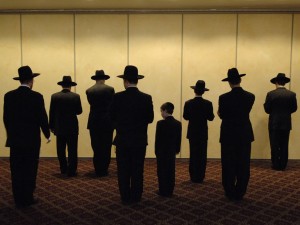 Ober, other prominent rabbis did not take these new customs sitting down and said the Tur (Rabbi Yaakov Ben Osher) that one should recite the Aseres Hadibrois privately. And said Rabbi Yoisef Caro: the ban applies only to reciting the Aseres Hadibrois during davening (services). They can be recited either in private or after the davening. So happens that a number of sidurim taka have the Aseres Hadibrois listed following the conclusion of the morning davening. Other rabbis decided to read them before the davening. Ober all that notwithstanding, what are we supposed to do today when they are being read in shul this coming shabbis? Stand or sit?
Ober, other prominent rabbis did not take these new customs sitting down and said the Tur (Rabbi Yaakov Ben Osher) that one should recite the Aseres Hadibrois privately. And said Rabbi Yoisef Caro: the ban applies only to reciting the Aseres Hadibrois during davening (services). They can be recited either in private or after the davening. So happens that a number of sidurim taka have the Aseres Hadibrois listed following the conclusion of the morning davening. Other rabbis decided to read them before the davening. Ober all that notwithstanding, what are we supposed to do today when they are being read in shul this coming shabbis? Stand or sit?
Shoin, believe it or not this argument was never fully resolved and listing every position is beyond the scope of this review. Ober said Professor Eliezer Bashan so gishmak azoy: “Perhaps we can learn from a similar question which Maimonides (the Rambam) answered: The rabbis said: “A man should not stand among those who sit nor sit among those who stand. One must always follow the custom of the majority as long as it does not transgress an expressed prohibition.”
So happens that the Rambam stated not to stand. He was mamish against standing for the very reason cited above. Given that we follow the Rambam’s rulings on kimat everything else, why taka do we stand? And the answer is: Ver veyst?
A gittin Shabbis-
The Oisvorfer Ruv
Yitz Grossman
